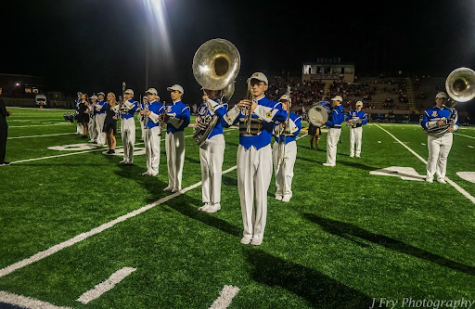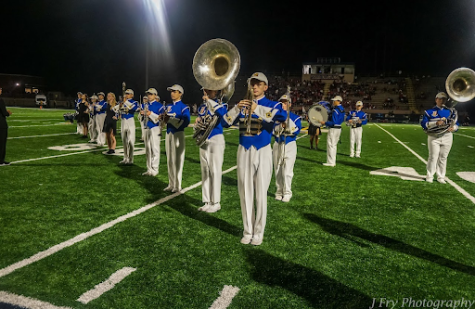Marching Band Return is Music to the Ears!

Oct 14, 2021
The marching band, like many extracurricular activities, underwent a massive change last year in response to COVID-19. Due to their high transmission risk, players of woodwind instruments had to shift to percussion-like drums and cymbals. This also meant the 2020 band could not march due to the increased size of the instruments. Fast forward one year, and the band has made its triumphant return to the field. But what exactly does it take to put on a highly coordinated performance like this?
Each season begins with learning basic commands and perfecting the marching technique at the two-week Marist Band Camp in July, where roll-stepping, a marching fundamental, is developed. Roll-stepping, which involves digging into the ground with the heel and keeping toes pointed upward as the foot rolls forward into another step, is what most marching bands use instead of high knees. The drum major, or conductor, gives commands for the band to practice marching transitions, which are vital in the show itself. This year, nearly half of all marchers had no experience marching. Joe Sansone ‘23, while a member of ba nd last year, is marching for the first time this year, and he describes learning the process as “pretty difficult, [but] thankfully everyone was helpful and patient.”
nd last year, is marching for the first time this year, and he describes learning the process as “pretty difficult, [but] thankfully everyone was helpful and patient.”
Once the basics are down, band members learn the charts, which show the formations the marchers will make. Each marcher receives a dot giving their position relative to the sideline and a certain yardline. The field is visualized as a coordinate plane system, where each marcher has a specific x and y coordinate that, when combined with other marchers, will form images such as a TV antenna or infinity symbol in this year’s show. Currently, there are over 40 unique dots for each marcher. The band spends two-plus-hour practices over three days each week practicing, much of it devoted to perfecting these shapes while keeping all the band members in a synchronized step with each other. Memorizing all of one’s dots is itself a difficult task, yet another level of complexity is factored in when playing music.
This year, the band is playing hit tunes from the Beatles, such as “A Hard Day’s Night,” “Lucy in the Sky With Diamonds,” and “Penny Lane.” When played together, the show runs for over five minutes. While the memorization of the music usually comes quicker to marchers than the dots, the larger challenge stems from keeping the entire band at a set tempo. The tempo not only determines the pace of the music but also the quickness of the marcher’s feet. MinhHoang Do ‘22, this year’s drum major, takes on the responsibility of making sure that all the musical sections play in unison while also ensuring that the individual steps of each marcher align with the others’. “I enjoy leading the band,” said Do, but he also likes being able “to grow closer to [the other band members.” As is true with any team, the chemistry between members makes the entire experience more meaningful.
The band has performances on Fridays during halftime of every varsity football game. Additionally, they are competing in three different band competitions throughout October. Every note and step in the show takes a largely invisible amount of effort and practice from the collective band. Be sure to give the Marist War Eagle Marching Band a listen!



